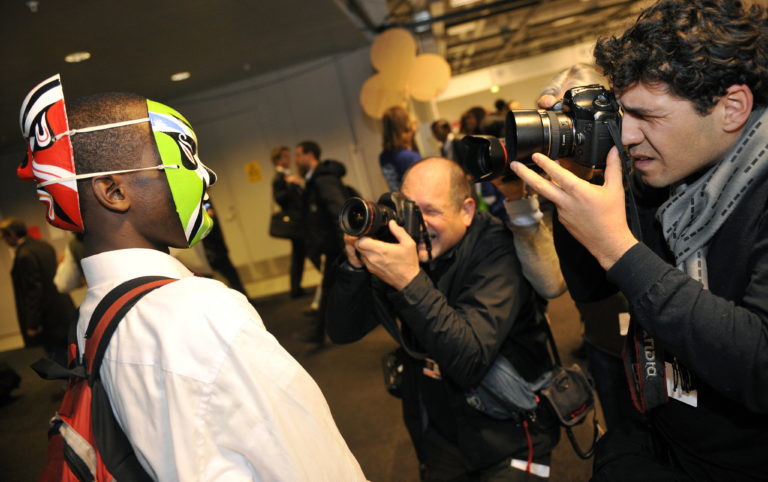
Image by Attila Kisbenedek/Getty Images, © All Rights Reserved.
Avoiding the Caricature Trap: Draw Out the Richness of Characters (Part I)
“Power is the ability not just to tell the story of another person, but to make it the definitive story of that person.”
So says Nigerian novelist Chimamanda Ngozi Adichie in her brilliant TED talk, “The danger of a single story.” If you haven’t watched it (as 10 million people to date have), you must immediately. She argues that there are far-reaching consequences when we see other people through simplistic tropes — the primitive African, the abject immigrant, the oppressed Arab woman.
So what is the cure for this cultural, and ultimately, political tragedy — the flattening out and de-humanizing of whole populations of people through an inadequate number and depth of stories?
It’s not rocket science: better stories. More of them. Told by a wider variety of people.
And yet, as obvious as the cure is, actually administering it turns out to be far trickier than it sounds. There are long-standing, though one might argue increasingly eroding, institutions in place that prize certain kinds of stories and certain kinds of storytellers over others: the publishing industry, the op-ed pages, big idea conferences, network news.
There are a lot of organizations (my favorites being The Op-Ed Project and, an organization I co-founded, FRESH), not only making a solid case for why we’re all dumber when the narrators and pundits in these spaces are overwhelmingly white and male, but actually shining a light on just the kinds of voices that are missing and ready to jump in. Call me naïve, but I actually believe that these organizations are fated victors. It’s just a matter of time before the demographic shifts in this country collude with their highly effective work to make the now normal preponderance of pale male authors seem downright peculiar.
And yet, even more diverse storytellers can’t make us immune to defaulting to a single story. I’ve come to believe that single stories are born, not just from inadequately seeing real people (although that is sometimes the case), but inadequately writing real people — creating caricatures rather than characters. This is a trap that even an insider can fall into if he doesn’t approach the challenge with intention. Think about critiques of filmmaker Tyler Perry and comedian George Lopez. It’s particularly seductive to traffic in single stories when a consumer base is eager to buy into them; the promise of laughs and money can speak louder than an inchoate sense of fealty to nuanced portraits, even of your own people.
Additionally, when the narrator is someone sympathetic to the demographic group, but not of it, they are especially vulnerable to the caricature trap. Imagine the nonprofit director speaking about the poor client she serves while in a fundraising meeting. Her goal is to create an emotional response in the foundation officer and to demonstrate how far the organization is able to take their clients, the proverbial ROI. In order to do that, she falls back on painting as bleak a picture as possible and turning the organization, not the client, into the protagonist.
Worse yet, she’s unlikely to include details that makes that client fallible or funny, or any other quality that — while true — would be distracting to her mission. Many of us who work in the nonprofit sector may pride ourselves as light years ahead of the Sally Struthers infomercials of yesteryear about starving children with flies in their eyes, but are we really so different?

Or imagine the journalist who is writing about a disenfranchised population — say the formerly incarcerated or undocumented immigrant — in order to build awareness of a pressing societal issue, but in trying to sketch a brief scenic lede (a mainstay in this kind of journalism), ends up inadvertently reinforcing the reader’s biases. A real life example:
“San Francisco residents have over decades become inured to encounters with the city’s homeless population, the clumps of humanity sleeping on sidewalks under coats and makeshift blankets, or drug addicts shooting up in full view of pedestrians. There are also the tension-filled but common scenes of mentally ill men and women stumbling down streets, arguing with imaginary enemies or harassing passers-by.”
The path to the single story, it turns out, is also paved with good intentions. The vistas are abstract. The people obscured. The reader or listener leaves the encounter with your narrative as convinced of their own stereotypes as they were to begin with, maybe even more convinced, and most dangerous of all, maybe not even aware of how convinced they really are. When we hear stories that feature caricatures, it builds a case for a dualistic, deeply inaccurate view of human nature — one where we often see whole groups of people as either victims or manipulators, heroes or villains.
We don’t see poor people as complex human beings, as complex as human beings with safety nets and bank accounts; we see them as fundamentally broken. We don’t see sexual assault survivors as brave and flawed in various proportions, just like any other person; we see them as victims. We don’t see investment bankers as grappling with their own ideas about success and integrity, just as we are; we see them as amoral money grubbers.
There is a little-noted secondary effect of the caricature: when we settle for sketches of people, rather than detailed drawings, we put the systems and cultures they are a part of out of focus, too. The motivation to make a system better is drained away by the sense that the people who are a part of it aren’t like you or me. Sure, we could figure out how to reinvent workforce development, but if unemployed people are hapless or lazy, what good will it do? Apathy is a close cousin of caricature.
Perhaps the biggest danger of all, next to the kind of violence that we are capable of when we don’t truly see “the other” as human, is pity. Pity is a kind of violence. When we don’t acknowledge the awe-inducing uniqueness of individuals, we strip them of their agency in our own minds. When we imagine them devoid of inner lives as powerful and complex as our own, we feel detached from them, maybe even bad for them. Pity is the death of wise relationship, of wise action. It is an end, never a beginning.
Or as Adichie herself put it so beautifully:
“The consequence of the single story is this: It robs people of dignity. It makes our recognition of our equal humanity difficult.”
May we always struggle to do the opposite — to restore dignity through telling and idiosyncratic details and, in so doing, make it easier to see one another’s storied complexity and inherent worthiness.
Next week, I continue this exploration with tips on how to avoid falling into the caricature trap in your own life and work.

Share your reflection